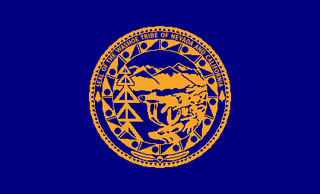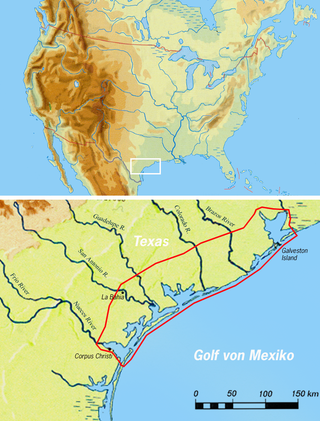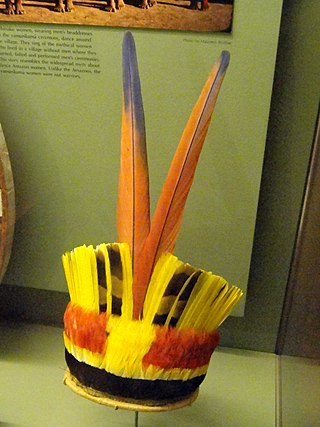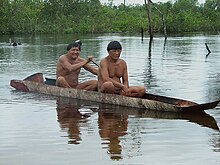
The Kalinago, formerly known as Island Caribs or simply Caribs, are an indigenous people of the Lesser Antilles in the Caribbean. They may have been related to the Mainland Caribs (Kalina) of South America, but they spoke an unrelated language known as Island Carib. They also spoke a pidgin language associated with the Mainland Caribs.

The Cariban languages are a family of languages indigenous to northeastern South America. They are widespread across northernmost South America, from the mouth of the Amazon River to the Colombian Andes, and they are also spoken in small pockets of central Brazil. The languages of the Cariban family are relatively closely related. There are about three dozen, but most are spoken only by a few hundred people. Macushi is the only language among them with numerous speakers, estimated at 30,000. The Cariban family is well known among linguists partly because one language in the family—Hixkaryana—has a default word order of object–verb–subject. Prior to their discovery of this, linguists believed that this order did not exist in any spoken natural language.

The Washoe or Wašišiw are a Great Basin tribe of Native Americans, living near Lake Tahoe at the border between California and Nevada. The name "Washoe" or "Washo" is derived from the autonym Waashiw in the Washo language or from Wašišiw (waší:šiw), the plural form of wašiw.

The Karankawa were an Indigenous people concentrated in southern Texas along the coast of the Gulf of Mexico, largely in the lower Colorado River and Brazos River valleys. They consisted of several independent seasonal nomadic groups who shared a language and some culture.

The Kamayurá are an indigenous tribe in the Amazonian Basin of Brazil. Their name is also spelled Kamayura and Kamaiurá; it means "a raised platform to keep meat, pots and pans." The Kamayurá language belongs to the Tupi–Guarani family.
The Kombai are a Papuan people living in the Indonesian province of South Papua, more specifically in Mappi Regency. Their total population is about 5,650.

The Patamona are an Amerindian people native to the Pakaraima Mountains of Guyana and northern Brazil. They speak a Cariban language, Kapóng, and have often been referred to interchangeably as Akawaio or Ingariko. Patamona are considered a sub-group of Kapon people.

Xingu people are indigenous people of Brazil living near the Xingu River. They have many cultural similarities despite their different ethnicity. Xingu people represent fifteen tribes and all four of Brazil's indigenous language groups, but they share similar belief systems, rituals and ceremonies.
The Panará are an Indigenous people of Mato Grosso in the Brazilian Amazon. They farm and are hunter-gatherers.
The Xingu Indigenous Park is an indigenous territory of Brazil, first created in 1961 as a national park in the state of Mato Grosso, Brazil. Its official purposes are to protect the environment and the several nations of Xingu Indigenous peoples in the area.
The Kuikuro are an indigenous people from the Mato Grosso region of Brazil. Their language, Kuikuro, is a part of the Cariban language family. The Kuikuro have many similarities with other Xingu tribes. They have a population of 592 in 2010, up from 450 in 2002.
The Matipu people are an indigenous people of Brazil. They live in the southern part of the Xingu Indigenous Park in the state of Mato Grosso. Their a population is estimated at about 149 individuals in 2011, up from population of 40 in the 1995 census. They are mainly of animist faith and share many cultural traits with other Xingu peoples.
The Aweti people are a group of Native Americans living in the Xingu Indigenous Park, close to the headwaters of the Xingu River in Brazil. The Aweti inhabit two villages in the region. One is called Tazu’jyretam, and the other is unnamed. Tazu’jyretam is the main village of the Aweti people, and has been inhabited since at least the 19th century. Tazu’jyretam also has a small port. Both of these villages are located in an area between the Curisevo and Tuatuarí rivers, which feed into the Xingu further upstream. Their population was 196 in 2011, up from 140 in 2006.

The Mehinaku, Mehináko or Mehinacu are an indigenous people of Brazil. They live in the Indigenous Park of the Xingu, located around the headwaters of the Xingu River in Mato Grosso. They currently reside in area around the Tuatuari and Kurisevo Rivers. They had a population of 254 in 2011, up slightly from 200 in 2002.
The Nahukuá are members of a small, indigenous ethnic group in the upper Xingu River area of Brazil. Their population was 146, as of 2010, making them the smallest group in the region.
The Cumanagoto people are a group of Native Americans in South America. Their language belongs to the Carib language family. Their territory extended originally over the ancient province of Nueva Andalucía in eastern Venezuela, and their descendants live now in the north of Anzoátegui State, Venezuela.

The Wauja or Waura are an indigenous people of Brazil. Their language, Waurá, is an Arawakan language. They live in the region near the Upper Xingu River, in the Xingu Indigenous Park in the state of Mato Grosso, and had a population of 487 in 2010.
The Ikpeng are an indigenous community that now lives in the Xingu Indigenous Park in Mato Grosso, Brazil. They had a population of 459 in 2010, up from a low of 50 in 1969.
Amonap, also known as Apalakiri, is a Cariban language spoken by the Kuikuro and Kalapalo peoples of Brazil, and formerly by the Matipu. It is spoken in seven villages along the Culuene River in the Xingu Indigenous Park of Mato Grosso.
The Ikpeng language is the language of the Ikpeng people who live in the Xingu Indigenous National Park in Mato Grosso, Brazil. There are approximately 500 speakers. Ikpeng is a language with high transmission, meaning it is passed on from parent to child at a high rate, with all members speaking the language. The majority of members are also bilingual speakers of Portuguese. The Ikpeng language is part of the Carib (Karib) language family.








